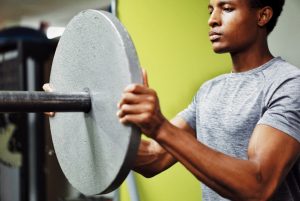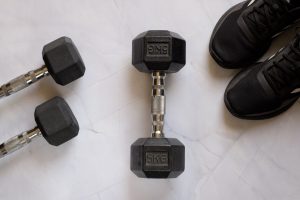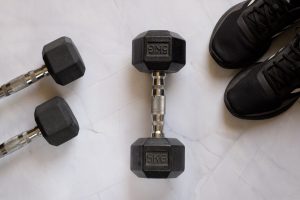Boost Back Strength & Shield Shoulders with Barbell Rows
Enhance your back strength and safeguard your shoulders with barbell rows. Discover effective techniques now and elevate your fitness game!
Benefits of Barbell Rows
Enhance Back Strength
Barbell rows are a cornerstone exercise for developing significant back strength. By engaging multiple muscle groups, including the latissimus dorsi, rhomboids, and trapezius, barbell rows help build a robust and powerful back.
This exercise is particularly effective in targeting the upper and middle back, which are essential for overall upper body strength and stability.
Consistent practice of barbell rows can lead to noticeable improvements in your ability to perform other compound lifts, such as deadlifts and squats, as a strong back is crucial for maintaining proper form and preventing injury during these movements.
Improve Shoulder Health
Barbell rows play a vital role in protecting and enhancing shoulder health. By strengthening the muscles around the shoulder girdle, this exercise helps stabilize the shoulder joint, reducing the risk of injury.
The rowing motion also promotes balanced muscle development, counteracting the effects of overdeveloped chest muscles, which can lead to shoulder impingement.
Additionally, barbell rows encourage proper scapular movement and posture, which are essential for maintaining shoulder integrity and function. This makes barbell rows an excellent exercise for athletes and individuals looking to improve shoulder mobility and prevent common shoulder issues.
Boost Core Stability
While primarily a back exercise, barbell rows also demand significant core engagement.
The need to maintain a stable and neutral spine throughout the movement activates the core muscles, including the abdominals and obliques. This engagement helps improve overall core stability and strength, which are crucial for athletic performance and daily activities.
By incorporating barbell rows into your routine, you not only enhance your back strength but also develop a more resilient core, contributing to better posture and reduced risk of lower back pain.
Versatile and Adaptable
Barbell rows are a versatile exercise that can be adapted to suit various fitness levels and goals.
Whether performed with a traditional overhand grip or a reverse grip, barbell rows can be modified to emphasize different muscle groups or address specific weaknesses. This adaptability makes them a valuable addition to any strength training program.
Furthermore, barbell rows can be easily incorporated into various training splits, whether you are focusing on full-body workouts, upper/lower splits, or push/pull routines.
Their versatility ensures that they can complement any training regimen, helping you achieve your fitness objectives more effectively.
Proper Form and Technique Tips
Setting Up Your Stance
Begin by standing with your feet shoulder-width apart, ensuring a stable base. Your toes should point slightly outward, which helps maintain balance.
Keep your knees slightly bent to avoid locking them, as this can lead to unnecessary strain on your joints. Position the barbell over the midfoot to ensure optimal leverage and control during the lift.
Grip and Hand Position
Grip the barbell with an overhand grip, slightly wider than shoulder-width.
This grip allows for better engagement of the back muscles while maintaining control over the bar. Ensure your wrists are straight and not bent, as this can cause discomfort and reduce the effectiveness of the exercise.
Maintaining a Neutral Spine
A neutral spine is crucial for preventing injuries during barbell rows.
To achieve this, hinge at the hips and push your buttocks back while keeping your chest up. Your back should remain flat, and your head in line with your spine.
Avoid rounding your shoulders or arching your back excessively, as this can lead to strain and potential injury.
Executing the Row
With your core engaged, begin the row by pulling the barbell towards your lower ribcage. Focus on squeezing your shoulder blades together as you lift the bar, which helps activate the upper back muscles.
Avoid using your arms to lift the weight; instead, think of your arms as hooks connecting your back to the bar.
Controlling the Descent
Lower the barbell in a controlled manner, allowing it to return to the starting position over your midfoot. Avoid letting the bar drop quickly, as this can lead to loss of control and potential injury.
Maintaining tension in your back muscles throughout the descent is key to maximizing the benefits of the exercise.
Breathing and Timing
Proper breathing enhances stability and performance during barbell rows. Inhale deeply before initiating the lift, and exhale as you pull the bar towards your body.
This breathing pattern helps stabilize your core and provides the necessary support for your spine. Ensure each repetition is deliberate and controlled, focusing on quality over quantity.
Variations to Target Different Muscle Groups
Standard Barbell Row
The standard barbell row is a fundamental exercise that primarily targets the upper back, including the rhomboids and trapezius muscles.
To perform this variation, stand with your feet shoulder-width apart and bend slightly at the hips, keeping your back straight. Pull the barbell towards your lower rib cage, squeezing your shoulder blades together at the top of the movement.
This exercise is excellent for building overall back strength and improving posture.
Underhand Grip Barbell Row
This variation shifts the focus towards the lower lats and biceps. By using an underhand grip, you engage the biceps more actively, while still targeting the back muscles.
To execute this move, hold the barbell with your palms facing up and perform the row as you would in the standard version. This grip can also reduce strain on the shoulders, making it a suitable option for those with shoulder concerns.
Single-Arm Barbell Row
The single-arm barbell row allows for greater range of motion and helps to correct muscle imbalances.
By isolating each side of the body, you can focus on strengthening weaker areas. To perform this variation, position yourself next to a bench for support.
With one hand on the bench, use the opposite hand to grip the barbell and row it towards your hip. This exercise not only targets the back but also engages the core for stability.
Wide-Grip Barbell Row
For those looking to emphasize the upper back and rear deltoids, the wide-grip barbell row is an effective choice.
By widening your grip on the barbell, you increase the involvement of the upper back muscles. This variation is performed similarly to the standard row, but with hands placed wider than shoulder-width apart.
It helps in developing a broader back and improving shoulder stability.
Yates Row
The Yates row, named after bodybuilder Dorian Yates, is a variation that targets the lower back and lats with a more upright posture. Stand with a slight bend in your knees and hold the barbell with an underhand grip.
Keep your torso more upright compared to the standard row and pull the bar towards your waist. This variation is particularly beneficial for those looking to increase back thickness and strength.
Injury Prevention and Shoulder Protection
Proper Form and Technique
Executing barbell rows with proper form is crucial for preventing injuries and protecting your shoulders.
Start with a light weight to master the technique before progressing to heavier loads. Ensure your back is straight, core engaged, and knees slightly bent.
Avoid rounding your back, as this can lead to unnecessary strain on your spine and shoulders.
Maintain a controlled motion throughout the exercise. Avoid jerking the weight, which can lead to muscle tears or joint injuries.
Focus on a smooth, steady lift and lower, ensuring your shoulder blades retract fully at the top of the movement.
Warm-Up and Mobility Exercises
Incorporating a thorough warm-up routine before performing barbell rows can significantly reduce the risk of injury. Start with dynamic stretches targeting the shoulders, back, and core.
Arm circles, shoulder rotations, and cat-cow stretches are effective in increasing blood flow and enhancing joint mobility.
Consider adding mobility exercises that focus on the scapula and shoulder joints. These exercises can improve your range of motion and prepare your muscles and tendons for the workload ahead, minimizing the risk of strains and sprains.
Gradual Progression and Load Management
To protect your shoulders and prevent injuries, it’s essential to progress gradually with the weight you lift.
Sudden increases in load can overwhelm your muscles and joints, leading to potential injuries. Follow a structured training plan that allows for consistent, incremental increases in weight.
Listen to your body and avoid pushing through pain.
If you experience discomfort in your shoulders or back, reduce the weight or take a break to assess your form and technique. Regularly incorporating rest days into your routine will also aid in recovery and injury prevention.
Strengthening Supporting Muscles
Building strength in the muscles that support your shoulders is key to preventing injuries.
Incorporate exercises that target the rotator cuff, traps, and rhomboids into your routine. These muscles play a vital role in stabilizing the shoulder joint during barbell rows.
Exercises such as face pulls, external rotations, and shrugs can enhance shoulder stability and strength.
By developing these supporting muscles, you can reduce the risk of imbalances and overuse injuries, ensuring your shoulders remain healthy and strong.
FAQ
Q1: How often should beginners incorporate barbell rows into their fitness routine to build back strength and protect their shoulders?
A1: For beginners, it’s recommended to incorporate barbell rows into your fitness routine 1-2 times per week. This frequency allows your muscles to adapt to the new exercise while minimizing the risk of overtraining and excessive soreness. Ensure you maintain proper form to protect your shoulders and back, and gradually increase the weight as you become more comfortable and stronger. Remember to allow at least 48 hours of rest between sessions targeting the same muscle group to promote recovery and growth.
Q2: What can advanced users do if they hit a plateau with their barbell row performance?
A2: Advanced users who hit a plateau with their barbell row performance can try several strategies to break through. First, consider varying your grip width or hand position to target different muscle fibers and stimulate growth. Additionally, incorporate progressive overload by gradually increasing the weight or adding more sets and reps. You can also introduce variations such as Pendlay rows or single-arm dumbbell rows to challenge your muscles differently. Finally, ensure you’re getting adequate nutrition and rest, as these are crucial for muscle recovery and growth.
Q3: How important is recovery timing for advanced users performing barbell rows, and how can it be optimized?
A3: Recovery timing is crucial for advanced users to maximize the benefits of barbell rows and prevent injuries. To optimize recovery, ensure you’re getting sufficient sleep, as this is when most muscle repair occurs. Incorporate active recovery techniques such as light stretching or yoga to improve flexibility and reduce muscle tension. Additionally, consider using foam rolling or massage therapy to enhance blood flow and aid in muscle recovery. Nutrition also plays a vital role; consuming a balanced diet rich in protein and essential nutrients supports muscle repair and growth. Aim to allow at least 48-72 hours of rest between intense back workouts to ensure full recovery.
Takeaway
“Ready to crush your fitness goals and unleash your full potential? Start your new workout challenge today, download our FREE training plan, and join our vibrant fitness community of like-minded individuals who are here to support and inspire you every step of the way. Let’s sweat, smile, and succeed together! Take the first step towards a stronger, healthier you – the time is NOW!”











Comments